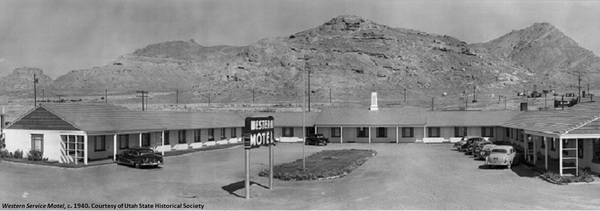Dublin Core
Title
Description
Utah’s booming tourism industry grew by attracting travelers with creature comforts that rivaled the scenery.
In the early twentieth century, Utah’s exceptional landscape drew Americans seeking to connect with nature and untamed wilderness. Initially they came by stagecoach and train, but by the mid-1900s better roads and personal automobiles allowed people to travel independently to scenic destinations like national parks and monuments. The influx of tourists created the need for accommodation, so new motels began appearing throughout southern Utah.
At first, the motels served as simple rest stops for tourists coming to see the natural beauty of Utah’s parks. A 1957 travel guide lists several motels in “gateway towns” such as Cedar City, Moab, and St. George at an average price of $6.50 per night! The guide touts Utah as the “center of scenic America” and urges visitors to come for an “unforgettable vacation.” But as competition grew, motels began advertising themselves as stand-alone destinations, with all the comforts and conveniences of home. In turn, tourists began to expect those conveniences. For example, one of the major complaints from tourists about a new information center in Zion National Park was the annoying lack of hamburgers and soft drinks.
So motels began to use those conveniences to lure travelers. In 1963, the Canyonlands Motel opened in remote Mexican Hat, Utah. Its brochure encouraged tourists to visit ancient ruins and the adjacent Navajo Reservation, and pointed them to nearby state and national parks. But its advertising focused just as heavily on the motel’s “complete travel facilities and accommodations,” including wall-to-wall carpeting, air-conditioning and heat, a shower and tub combination, and sliding doors to an outdoor swimming pool.
The need to accommodate tourists has only increased in subsequent years. Utah hosts millions of visitors who spend billions of dollars each year. They still vacation here to enjoy the natural beauty, but expect to return at night to an air-conditioned motel room. For the modern traveler, comfort and convenience might be just as important as the scenery.
Creator
Heidi Orchard for Utah Humanities © 2014
Source
Image: Western Service Motel, c. 1940. Image shows a small motel and adjacent service stations, somewhere in a southern Utah town. Courtesy of Utah State Historical Society.
_______________
Church, Lisa Michele, “Early Roadside Motels and Motor Courts in St. George,” Utah Historical Quarterly, 80(1), 2012, pp. 22-43, accessible online at http://utahhistory.sdlhost.com/#/item/000000033000261/view/4; Clark, John and Melissa, Opening Zion: A Scrapbook of the National Park’s First Official Tourists, Salt Lake City, Utah: Bonneville Books, 2010; Canyonlands Motel , 1963, Utah State History, Pamphlet 9455; Stringham, J. T., Utah Motel Guide, 1957-58, Utah State History Pamphlet 3869, Utah Development Services; Utah!: the fall 1969 report on tourism, industry, and arts in Utah, 1969, Utah State History Pamphlet 12567; Lee, Jasen, “Tourism still bringing in big bucks to Utah,” Deseret News, 9/21/2012, accessed www.deseretnews.com.
Publisher
The Beehive Archive is a production of Utah Humanities. Find sources and the whole collection of past episodes at www.utahhumanities.org
Date
2014-08-01

